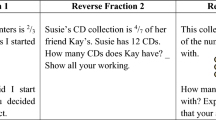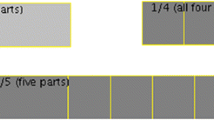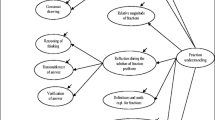Abstract
The aim of this study was to propose and validate a structural model in fraction and decimal number addition, which is founded primarily on a synthesis of major theoretical approaches in the field of representations in Mathematics and also on previous research on the learning of fractions and decimals. The study was conducted among 1701 primary and secondary school students. Eight components, which all involve representational transformations, were encompassed under the construct of representational flexibility in fraction and decimal number addition. This structure reveals that, for both concepts, the representational transformation competences of recognition and conversion, and therefore representational flexibility as well, were affected by the complexity of the concepts involved and the direction of the conversion, respectively. Results also showed that two first-order factors were needed to explain the problem-solving ability in fraction and decimal number addition, indicating the differential effect of the modes of representation that is diagrammatic and verbal form on problem-solving ability irrespective of the concepts involved, as in the case of the conversions. Representational flexibility and problem-solving ability were found to be major components of students’ representational thinking of fraction and decimal number addition. The proposed framework was invariant across the primary and secondary school students. Theoretical and practical implications are discussed.



Similar content being viewed by others
References
Acevedo Nistal, A., Van Dooren, W., Clarebout, G., Elen, J. & Verschaffel, L. (2009). Conceptualising, investigating and stimulating representational flexibility in mathematical problem solving and learning: A critical review. ZDM Mathematics Education, 41, 627–636.
Alajmi, A. H. (2012). How do elementary textbooks address fractions? A review of mathematics textbooks in the USA, Japan, and Kuwait. Educational Studies in Mathematics, 79(2), 239–261.
Barnett-Clarke, C., Fisher, W., Marks, R. & Ross, S. (2010). Developing essential understanding of rational number: Grades 3–5. Reston, VA: National Council of Teachers of Mathematics.
Bentler, M. P. (1990). Comparative fit indexes in structural models. Psychological Bulletin, 107, 301–345.
Boulet, G. (1998). Didactical implications of children’s difficulties in learning the fraction concept. Focus on Learning Problems in Mathematics, 20(4), 19–34.
Carlson, M. & Bloom, I. (2005). The cyclic nature of problem solving: An emergent multidimensional problem-solving framework. Educational Studies in Mathematics, 58, 45–75.
Charalambous, C. Y. & Pitta-Pantazi, D. (2007). Drawing on a theoretical model to study students’ understandings of fractions. Educational Studies in Mathematics, 64(3), 293–316.
Cramer, K., Post, T. & delMas, R. (2002). Initial fraction learning by fourth- and fifth-grade students: A comparison of the effects of using commercial curricula with the effects of using the rational number project curriculum. Journal for Research in Mathematics Education, 33(2), 111–144.
Cramer, K. & Wyberg, T. (2009). Efficacy of different concrete models for teaching the part-whole construct for fractions. Mathematical Thinking and Learning, 11(4), 226–257.
Deliyianni, E., Elia, I., Panaoura, A. & Gagatsis, A. (2007). The functioning of representations in Cyprus mathematics textbooks. In E.P. Avgerinos & A. Gagatsis (Eds.). Current Trends in Mathematics Education (pp. 155–167). Rhodes, Greece: Cyprus Mathematics Society & University of Aegean.
Desmet, L., Grégoire, J. & Mussolin, C. (2010). Developmental changes in the comparison of decimal fractions. Learning and Instruction, 20(6), 521–532.
Duval, R. (2006). A cognitive analysis of problems of comprehension in learning of mathematics. Educational Studies in Mathematics, 61, 103–131.
Elia, I., Gagatsis, A. & Demetriou, A. (2007). The effects of different modes of representation on the solution of one step additive problem. Learning and Instruction, 17, 658–672.
Empson, S. B., Levi, L. & Carpenter, T. P. (2011). The algebraic nature of fractions: Developing relational thinking in elementary school. In J. Cai & E. J. Knuth (Eds.), Early algebraization (pp. 409–428). Berlin, Germany: Springer.
Gagatsis, A. & Shiakalli, M. (2004). Ability to translate from one representation of the concept of function to another and mathematical problem solving. Educational Psychology, 24, 645–657.
Goldin, G. A. (2003). Representation in school mathematics: A unifying research perspective. In J. Kilpatrick, W. G. Martin & D. Schifter (Eds.), A research companion to principles and standards for school mathematics (pp. 275–285). Reston, VA: The National Council of Teachers of Mathematics.
Hiebert, J., Wearne, D. & Taber, S. (1991). Fourth graders’ gradual construction of decimal fractions during instruction using different physical representations. Elementary School Journal, 91, 321–341.
Hitt, F. (1998). Difficulties in the articulation of different representations linked to the concept of function. The Journal of Mathematical Behavior, 17(1), 123–134.
Irwin, K. C. (2001). Using everyday knowledge of decimals to enhance understanding. Journal for Research in Mathematics Education, 32(4), 399–420.
Iuculano, T. & Butterworth, B. (2011). Understanding the real value of fractions and decimals. The Quarterly Journal of Experimental Psychology, 64(11), 2088–2098.
Jordan, N. C., Hansen, N., Fuchs, L. S., Siegler, R. S., Gersten, R. & Micklos, D. (2013). Developmental predictors of fraction concepts and procedures. Journal of Experimental Child Psychology, 116, 45–58.
Keijzer, R. & Terwel, J. (2003). Learning for mathematical insight: A longitudinal comparative study on modeling. Learning and Instruction, 13, 285–304.
Kline, R. B. (1998). Principles and practice of structural equation modeling. New York, NY: Guilford.
Kong, S. C. & Kwok, L. F. (2003). A graphical partitioning model for learning common fraction: Designing affordances on a web-supported learning environment. Computers and Education, 40, 137–155.
Lambdin, D. (2003). Benefits of teaching through problem solving. In F. Lester (Ed.), Teaching mathematics through problem solving: Prekindergarten-Grade 6 (pp. 3–13). Reston, VA: NCTM.
Lamon, S. L. (2001). Presenting and representing: From fractions to rational numbers. In A. Cuoco & F. Curcio (Eds.), The role of representations in school mathematics—2001 yearbook (pp. 146–165). Reston, VA: NCTM.
Lesh, R., Post, T. & Behr, M. (1987). Representations and translations among representations in mathematics learning and problem solving. In C. Janvier (Ed.), Problems of representation in the teaching and learning of mathematics (pp. 33–40). Hillsdale, NJ: Lawrence Erlbaum Associates.
Moss, J. & Case, R. (1999). Developing children’s understanding of the rational numbers: A new model and an experimental curriculum. Journal for Research in Mathematics Education, 30(2), 122–147.
National Council of Teachers of Mathematics (2000). Principles and standards for school mathematics. Reston, VA: Author.
Ni, Y. (2001). Semantic domains of rational numbers and the acquisition of fraction equivalence. Contemporary Educational Psychology, 26, 400–417.
Niemi, D. (1996). Assessing conceptual understanding in mathematics: Representations, problem solutions, justifications, and explanations. The Journal of Educational Research, 89(6), 351–363.
Schnotz, W. (2002). Towards an integrated view of learning from text and visual displays. Educational Psychology Review, 14(1), 101–120.
Schoenfeld, A. H., Smith, J. P. & Arcavi, A. (1993). Learning: The microgenetic analysis of one student’s evolving understanding of a complex subject matter domain. In R. Glaser (Ed.), Advances in instructional psychology (Vol. 4, pp. 55–176). Hillsdale, NJ: Lawrence Erlbaum Associates.
Sowder, J. (1997). Place value as the key to teaching decimal operations. Teaching Children Mathematics, 3(8), 448–453.
Steffe, L. P. & Olive, J. (2010). Children’s fractional knowledge. New York, NY: Springer.
Teppo, A. & van den Heuvel-Panhuizen, M. (2014). Visual representations as objects of analysis: The number line as an example. ZDM Mathematics Education, 46(1), 45–58. doi:10.1007/s11858-013-0518-2.
Thomas, M. O. J. (2008). Developing versatility in mathematical thinking. Mediterranean Journal for Research in Mathematics Education, 7(2), 71–91.
Verschaffel, G., Greer, B. & Torbeyns, J. (2006). Numerical thinking. In A. Gutierrez & P. Boero (Eds.), Handbook of research on the psychology of mathematics education: Past, present, and future (pp. 51–82). Rotterdam, Netherlands: Sense Publishers.
Whitley, J., Lupart, J. & Beran, T. (2007). Differences in achievement between adolescents who remain in A K–8 school and those who transition to a junior high school. Canadian Journal of Education, 30(3), 649–669.
Acknowledgments
The study reported in this article was supported by a program grant from the University of Cyprus (MED19: “The role of multiple representations in mathematical learning during the transition within and between primary and secondary school”).
Author information
Authors and Affiliations
Corresponding author
Electronic supplementary material
Below is the link to the electronic supplementary material.
ESM 1
(DOCX 224 kb)
Rights and permissions
About this article
Cite this article
Deliyianni, E., Gagatsis, A., Elia, I. et al. Representational Flexibility and Problem-Solving Ability in Fraction and Decimal Number Addition: A Structural Model. Int J of Sci and Math Educ 14 (Suppl 2), 397–417 (2016). https://doi.org/10.1007/s10763-015-9625-6
Received:
Accepted:
Published:
Issue Date:
DOI: https://doi.org/10.1007/s10763-015-9625-6




